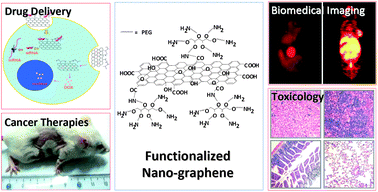Nano-graphene in biomedicine: theranostic applications
Abstract
Owing to their unique physical and chemical properties, graphene and its derivatives such as graphene oxide (GO), reduced graphene oxide (RGO) and GO-nanocomposites have attracted tremendous interest in many different fields including biomedicine in recent years. With every atom exposed on its surface, single-layered graphene shows ultra-high surface area available for efficient molecular loading and bioconjugation, and has been widely explored as novel nano-carriers for drug and gene delivery. Utilizing the intrinsic near-infrared (NIR) optical absorbance, in vivo graphene-based photothermal therapy has been realized, achieving excellent anti-tumor therapeutic efficacy in animal experiments. A variety of inorganic nanoparticles can be grown on the surface of nano-graphene, obtaining functional graphene-based nanocomposites with interesting optical and magnetic properties useful for multi-modal imaging and imaging-guided cancer therapy. Moreover, significant efforts have also been devoted to study the behaviors and toxicology of functionalized nano-graphene in animals. It has been uncovered that both surface chemistry and sizes play key roles in controlling the biodistribution, excretion, and toxicity of nano-graphene. Biocompatibly coated nano-graphene with ultra-small sizes can be cleared out from body after systemic administration, without rendering noticeable toxicity to the treated mice. In this review article, we will summarize the latest progress in this rapidly growing field, and discuss future prospects and challenges of using graphene-based materials for theranostic applications.


 Please wait while we load your content...
Please wait while we load your content...